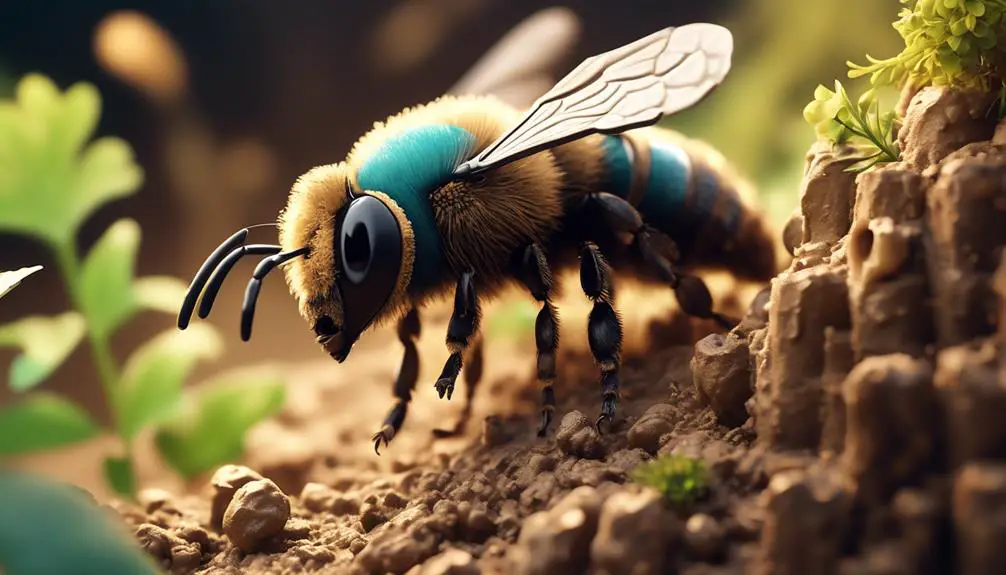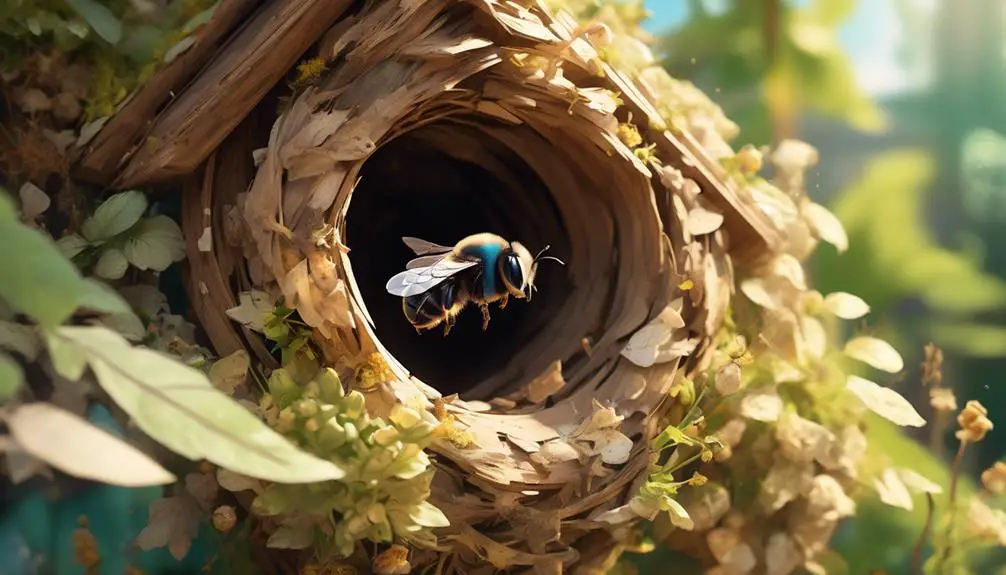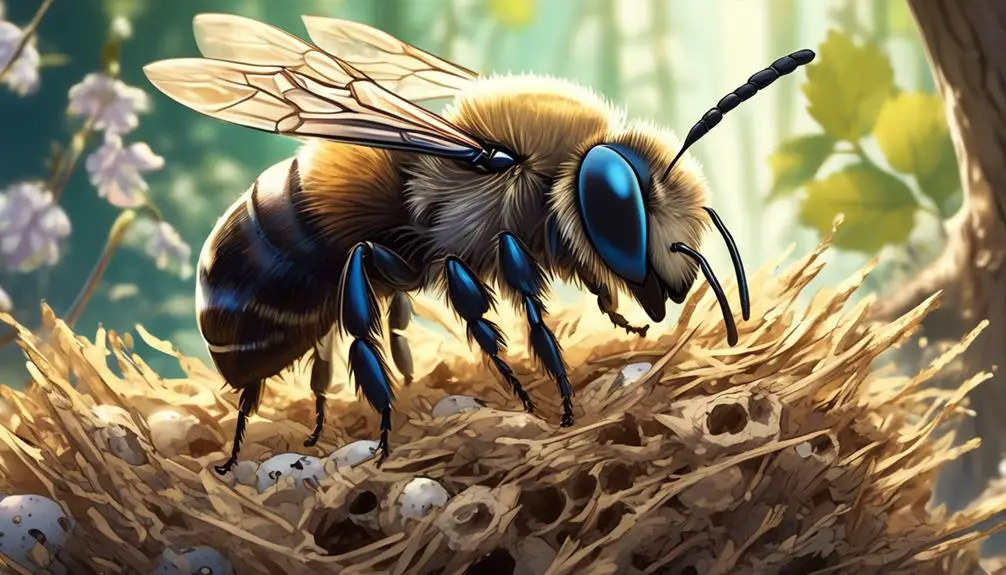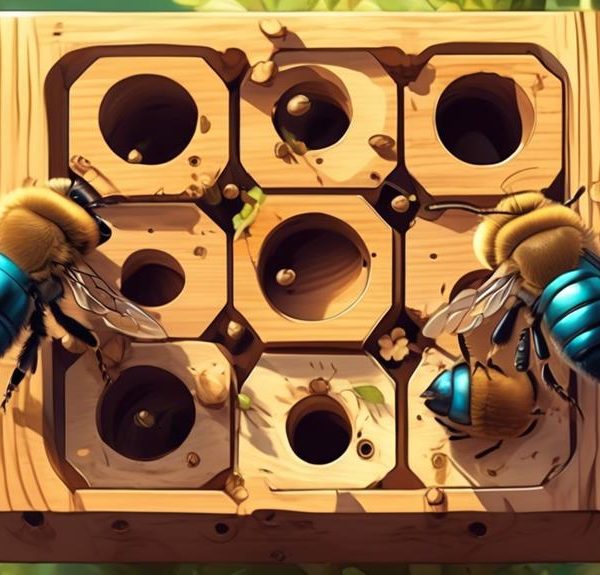An intriguing exploration into whether mason bees reuse their nests, shedding light on their unique behavior and crucial role in the ecosystem.

Do Mason Bees Reuse Their Nests?
Isn't it curious how you've stumbled upon the fascinating world of mason bees? These tiny creatures, known for their solitary nature and lovely blue hue, are often a topic of discussion among bee enthusiasts and environmentalists.
One question that may pique your interest is whether mason bees reuse their nests. It's a seemingly simple inquiry, but you'll find that the answer is intricately linked to their unique behavior, lifecycle, and the environment they inhabit.
Unraveling this mystery will not only give you insights into the lives of these industrious insects, but also highlight their crucial role in our ecosystem.
Are you ready to embark on this journey of discovery?
Key Takeaways
- Mason Bees are solitary bees that do not live in colonies like honeybees.
- They build individual nests in pre-existing holes or cavities and seal them with mud.
- Mason Bees prefer occupying clean, vacant nesting sites but will reuse old nests if necessary.
- Nest reuse conserves energy, ensures avoidance of harmful pathogens, and reflects their resourcefulness and survival instinct.
Understanding the Mason Bee Species

What exactly makes the Mason Bee species unique, you might wonder? Well, let's delve into the fascinating world of these industrious insects to uncover the truth.
Mason Bees, scientifically known as Osmia, are solitary bees, meaning they don't live in colonies like their honeybee cousins. Instead, each female is an independent queen who mates, builds her nest, and lays her eggs without the assistance of worker bees.
Now, you're probably thinking, 'where do Mason Bees get their name?' They're named for their remarkable nest-building habits. They use mud to construct their nests, much like a mason uses mortar. The female bee collects mud and forms it into a tube-like structure, then lays an egg inside. She then seals the entrance with more mud, creating a protective chamber for the developing larva.
Interestingly, Mason Bees are more efficient pollinators than honeybees. They carry pollen on their abdomen, allowing for more direct contact with flowers, leading to more effective pollination. Additionally, they're less aggressive and rarely sting, making them a favored species among bee enthusiasts.
Mason Bees' Unique Nesting Habits

Delving deeper into their nesting habits, you'll find that Mason Bees exhibit a unique approach to nest reuse, a behavior not commonly seen in other bee species. Unlike honeybees or bumblebees, which construct elaborate hives, Mason Bees are solitary creatures. They build individual nests, often in pre-existing holes or cavities and seal them with mud.
When it comes to nest reuse, Mason Bees are somewhat opportunistic. Their preference is to occupy a clean, vacant nesting site. However, if such a site isn't readily available, they'll reuse an old nest. Here's where it gets intriguing: Before reoccupying, they meticulously clean out any remnants of previous occupants, including parasites or fungi.
This behavior is both strategic and advantageous. By reusing a nest, they conserve energy which would have been used to construct a new one. The cleaning process also ensures they're not inheriting any potentially harmful pathogens.
In a nutshell, Mason Bees' nesting habits reflect a fascinating blend of resourcefulness, cleanliness, and survival instinct. Their unique approach to nest reuse contributes significantly to their resilience and adaptability across various habitats.
Factors Influencing Nest Reuse

Several factors can sway a Mason Bee's decision to reuse a nest. Firstly, you should understand that Mason Bees are opportunistic when it comes to choosing their nests. They'll nest in pre-existing cavities rather than expend energy digging their own. If they find a suitable site that's unoccupied, they'll take it over, even if it's a previously used nest.
Next, consider parasites. If a nest is infested, a bee is less likely to reuse it. Parasites pose significant risks to the bee's offspring. Hence, it's safer to abandon an infested nest and find a new one, which can be labor-intensive but necessary for survival.
Lastly, environmental conditions also play a role. These bees favor nests in sunny locations and will abandon those in overly shaded or damp areas. Additionally, if the surrounding flora doesn't provide enough nectar and pollen, they might vacate the nest.
Common Misconceptions About Mason Bees

While understanding the factors influencing nest reuse by Mason Bees is crucial, it's equally important to debunk some common misconceptions about these industrious pollinators.
Firstly, Mason Bees aren't honey producers. These solitary insects are primarily pollinators, not honeybees. Unlike honeybees, they don't live in large colonies or produce honey. Instead, they spend their lives pollinating plants and laying eggs in small, individual nests.
Secondly, they're not aggressive. It's a common misconception that all bees sting, but Mason Bees are non-aggressive and only sting when threatened or handled roughly. They're safe around children and pets, making them ideal for backyard pollination.
Another misconception is that Mason Bees are destructive to wooden structures. In reality, they prefer to nest in pre-existing holes and are unlikely to cause significant damage to your home or property.
Lastly, it's often believed that these bees require constant attention and care. However, Mason Bees are low maintenance and need minimal assistance once their nests are established. They do their job and you can enjoy the benefits of their pollination without constant monitoring.
The Impact of Nest Reuse on Ecosystem

Understanding the impact of nest reuse by Mason Bees on the ecosystem, you'll find it's a significant factor in maintaining biodiversity and promoting healthy plant growth. As these bees reuse their nests, they contribute to a cycle of life that's vital to our ecosystem.
They're excellent pollinators, outperforming many other bee species, including honeybees. With their unique method of carrying pollen on their abdomen, they effectively pollinate a wider variety of plants, enhancing biodiversity. This pollination increases plant reproduction and diversity, creating a healthier and more resilient ecosystem.
The reuse of nests also reduces the energy and resources needed to construct new nests. This energy efficiency promotes the survival of the Mason Bees, strengthening the stability of the ecosystem. It also minimizes the disturbance to their environment, preserving the integrity of habitats.
However, nest reuse does have potential downsides. It may increase the risk of parasitic infestation and disease transmission. Therefore, proper monitoring and management of Mason Bee population and nesting habits are crucial to maximize the benefits and minimize the risks to the ecosystem.
Conclusion
You've explored mason bees' intriguing nesting habits, discovering they rarely reuse nests due to parasite risks. This contradicts common misconceptions about these diligent pollinators.
Nest reuse impacts the ecosystem by controlling parasite populations and promoting biodiversity. Understanding and respecting their unique behaviors can aid in their conservation efforts.
So next time you spot a mason bee, remember, their life is a fascinating cycle of creation and renewal.



